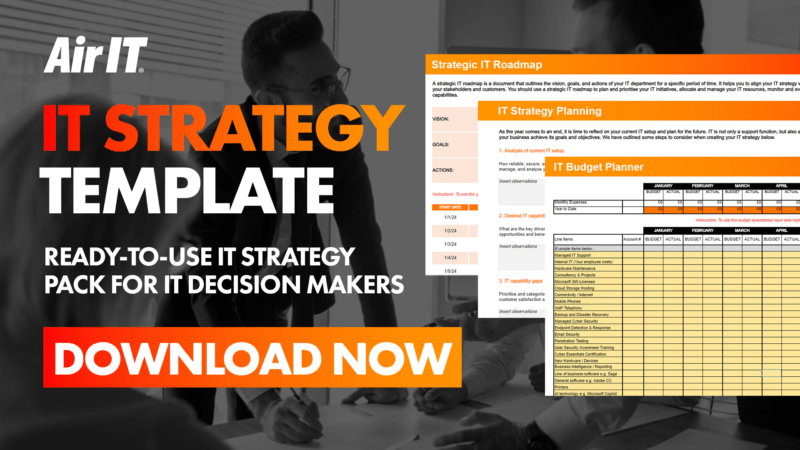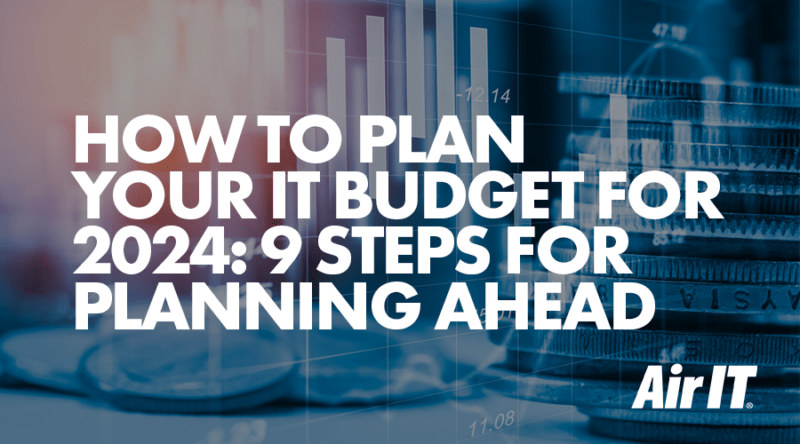The new year is here, and it's the perfect time to rethink how your business can use technology to grow and succeed. IT isn't just about fixing problems; it's a way to make you more competitive. Below, we have outlined essential steps to assist in shaping an IT strategy that leads to success.

A well-planned and effective IT strategy will give you the confidence to plan your IT investments in a way that improves your organisation and protects your business.
Producing a successful IT strategy takes careful planning, but with the right guidance and some simple tools, it’s not as hard as you think. We’ve listed the critical steps that will help you create a successful IT strategy and produced a set of tools to guide you through the process.
Step 1: Analysis of current IT setup
The first step is to analyse your current IT infrastructure and assess its strengths and weaknesses.
- How reliable, secure, scalable, and cost-effective is your IT infrastructure?
- How well do your IT applications support your business processes and functions?
- How do you collect, store, manage, and analyse your data?
- How efficient, effective, and agile are your IT processes?
Step 2: Desired IT capabilities
The next step is to define your desired IT capabilities for the year, aligning your IT objectives with your business vision.
- What are the key drivers and trends that will impact your business and IT in 2024?
- What are the key challenges and risks that you need to address and mitigate in 2024?
- What are the key opportunities and benefits that you want to pursue and achieve in 2024?
- What are the key capabilities and competencies that you need to develop and enhance in your IT in 2024?
Step 3: IT capability gaps
The third step is to prioritise and categorise your IT capability gaps based on their impact and urgency.
- How much does the gap affect your business performance?
- How much does the gap affect your customer satisfaction and loyalty?
- How soon does the gap need to be addressed?
- How much time and resources do you have to resolve the gap?
Step 4: IT investment plan
The final step is to create your IT investment plan for 2024.
- What are the specific actions and initiatives that you will undertake to address and resolve your IT capability gaps?
- What are the expected outcomes and benefits that you will achieve?
- When will you start and finish these projects?
- How much will you need to spend and invest?
- What is the expected return and value that you will generate from your IT investment?
- Who are the people and parties that are involved?
Key considerations for your IT strategy
The above steps can help you create a strong and strategically aligned IT framework that can effectively meet the demands and take advantage of the opportunities in 2024. However, it is important to keep in mind a few key factors while developing your IT strategy:
- Stay up to date with technology trends: It is crucial to keep up with the latest technological advancements to identify new opportunities and stay ahead of the competition. Technology is constantly evolving, some of the key technology trends to watch out for in 2024 include AI, sustainable technology, blockchain, and IoT.
- Prioritise cyber security: As technology advances, cyber threats are becoming more complex and sophisticated, posing greater risks to organisations worldwide. Therefore, having a robust cyber security strategy in place is crucial.
- Scalability and flexibility: It is important to create systems and processes that can expand with your business needs and adapt easily to changes in technology and operations.
- Embrace the cloud: Cloud computing is becoming increasingly popular due to its range of benefits, including increased flexibility, scalability, and cost savings. As you build your IT strategy for 2024, consider how you can leverage the cloud to achieve your business goals.
- Stakeholder collaboration: Involving key stakeholders helps to align the IT strategy with your wider business goals and objectives, ensuring that the strategy caters to different functional needs.
- Vendor selection: By identifying and partnering with vendors whose offerings align with your business’s needs, goals, standards, and budget, organisations can gain a competitive edge, reduce risks, enhance service offerings, and gain access to specialised expertise.
- Review and adapt: It’s important to regularly review and adjust your IT strategy based on feedback, emerging technologies, and changes in the business landscape.
Get started on your 2024 IT strategy today
Organisations are increasingly relying on digital technologies to stay competitive. However, without a flexible and highly skilled IT strategy, achieving success can be challenging.
Download our ready-to-use IT strategy template pack that enables you to build a clear and coherent IT strategy that aligns with your wider business goals and objectives. If you need assistance with implementing an effective IT strategy, please don’t hesitate to get in touch.





